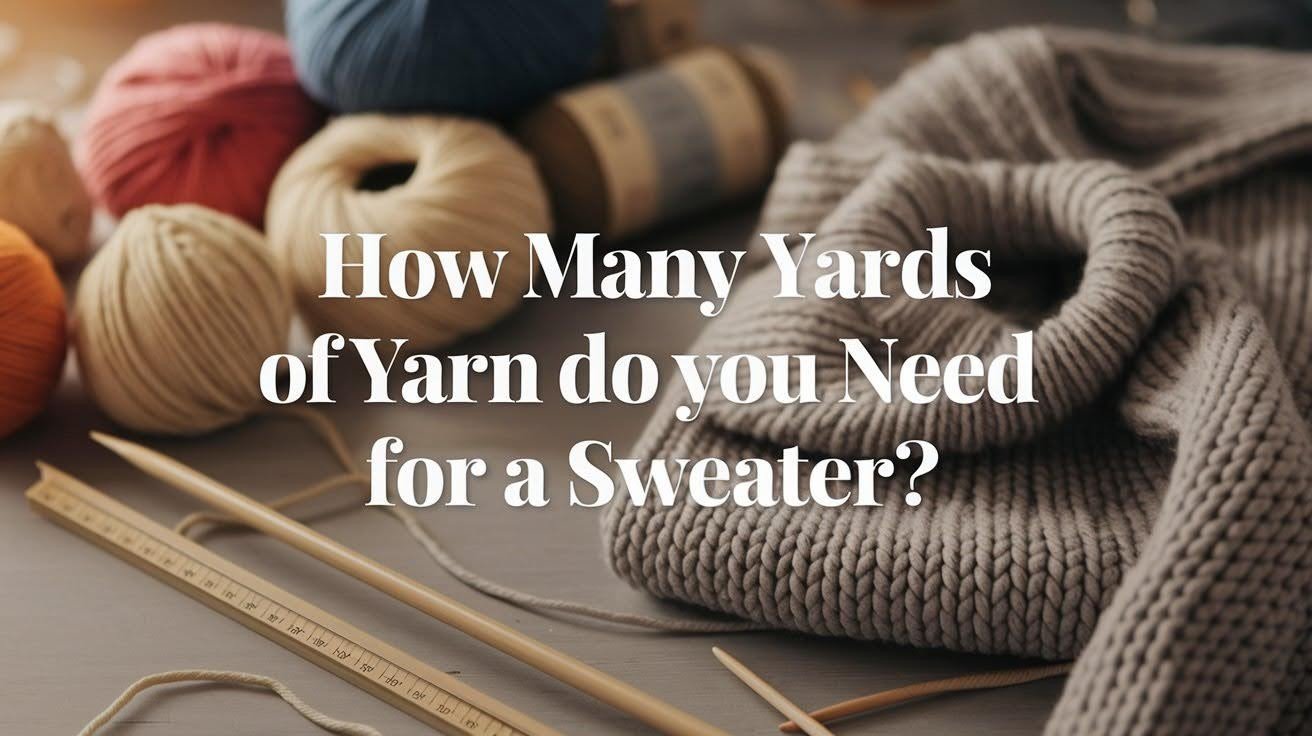I’ve been there. Halfway through knitting a cozy sweater, only to realize I’m running dangerously low on yarn. Or finishing a project with three full skeins still sitting in my basket, mocking my poor planning.
Sound familiar? You’re not alone.
After years of making these same mistakes (and learning from seasoned knitters who’ve been through it all), I’ve figured out reliable ways to calculate exactly how much yarn you need before casting on that first stitch.
In this post, I’ll walk you through simple methods to estimate yarn requirements for any sweater project. We’ll cover different yarn weights, sizing considerations, and those tricky pattern adjustments that can throw off your calculations.
No more mid-project panic trips to the yarn store. No more buying way too much “just in case.”
Let’s get your yarn planning sorted once and for all.
Understanding Yarn Weight and Yardage
Getting familiar with yarn weights and yardage will save you from buying too little or way too much yarn for your sweater.

What Is Yarn Weight?
Here’s something that confused me for ages: yarn weight has nothing to do with how heavy your skein feels in your hands. It’s actually about how thick the individual strands are.
Think of it like this – lace weight is super thin and delicate. Fingering weight is still thin but a bit sturdier. Sport and DK (double knitting) sit in the middle. Worsted weight is what most people think of as “regular” yarn. Then you’ve got chunky and super chunky for those thick, cozy projects.
For sweaters, I usually stick with fingering through worsted weights. Beginners often find worsted weight forgiving – it’s thick enough to see your stitches clearly and works up reasonably fast. More experienced knitters might choose fingering weight for fitted cardigans or DK for that perfect drape.
Yardage Basics
Here’s where the math gets interesting.
A medium adult sweater typically needs:
- Fingering weight: 1,600-2,200 yards
- DK weight: 1,200-1,600 yards
- Worsted weight: 1,000-1,400 yards
The thicker your yarn, the less yardage you need. Makes sense, right? Each stitch covers more ground with bulky yarn than with thin fingering weight.
General Yarn Requirements by Sweater Size and Yarn Weight
Here are the yardage ranges I use as my starting point when planning any sweater project.

Fingering Weight Yarn
I love fingering weight for its versatility, but wow does it eat up yardage. For those tiny baby sweaters, you’re looking at 400-600 yards. Kids’ sizes bump up to 650-900 yards. Adult sweaters? Plan for 1000-1800 yards.
I made a lace yoke pullover last year and used every bit of 1,600 yards. Baby cardigans are sweet projects that usually come in around 500 yards for newborn sizes.
DK Weight Yarn
DK is my go-to for so many projects. The yardage is more reasonable – babies need 300-450 yards, kids require 500-750 yards, and adults fall in the 800-1400 yard range.
I knit a gorgeous striped pullover in DK last winter using about 1,200 yards. Cabled sweaters in this weight look fantastic and typically need the higher end of these ranges because cables eat up extra yarn.
Worsted Weight Yarn
Worsted weight is perfect when you want something substantial without the massive yardage commitment. Babies only need 250-350 yards, kids 400-650 yards, and adults 700-1200 yards.
My favorite Aran sweater used 1,100 yards of worsted weight. Those oversized cardigans that are so popular right now? They usually hit around 1,000 yards for a medium size.
Factors That Influence Yarn Consumption
Several design choices and technical factors can dramatically change how much yarn your sweater actually needs.

1. Sweater Type and Style
The style you choose makes a huge difference in your yarn budget. I learned this the hard way when I planned for a regular pullover but decided halfway through to make it tunic-length. Suddenly I needed 300 more yards.
Cropped sweaters obviously use less yarn than full-length ones. Sleeveless tops can save you 200-400 yards compared to long sleeves. And those oversized, cozy fits everyone loves? They can add 20-30% more yarn to your project compared to a fitted design.
2. Stitch Patterns and Techniques
This is where things get tricky. Plain stockinette stitch uses the least yarn. Garter stitch needs about 25% more because you’re working twice as many rows for the same height.
Cables are yarn hogs – they can add 15-20% to your total yardage because all that twisting and crossing creates extra fabric. I made a cabled cardigan that needed 300 yards more than the pattern suggested.
Colorwork, bobbles, and lace inserts all bump up your yarn needs too. Those cute bobbles on my last sweater? Each one used an extra few inches of yarn.
3. Yarn Fiber and Ply
Here’s something most patterns don’t mention: different fibers behave differently. Cotton doesn’t stretch like wool, so you might need more yardage to get the same coverage. Acrylic tends to be lighter and fluffier, which can affect how much you actually use.
Yarn ply matters too. A 4-ply worsted weight might use different yardage than a single-ply worsted of the same thickness because of how the fibers are twisted together.
4. Needle Size and Gauge
I cannot stress this enough: always make a gauge swatch. I know it’s boring, but it’s the only way to predict your actual yarn usage.
Your gauge might be different from the pattern designer’s, even with the same needles. I knit looser than most patterns assume, so I often need bigger needles and slightly more yarn.
Use your gauge swatch to calculate: measure a 4-inch square, count your stitches and rows, then figure out how much yarn that square used. Scale it up for your whole sweater.
Estimating Yarn for Custom and Modified Patterns
When you start tweaking patterns or creating your own designs, you’ll need to calculate yarn requirements from scratch.

Planning for Personal Touches
I’m always tweaking patterns to make them more “me.” Want to add 4 inches of length to that cropped sweater? Calculate roughly 10-15% more yarn for most weights. Planning a contrasting border? Measure how wide and long it’ll be, then estimate based on your gauge.
Mixing yarns gets tricky fast. I once combined a tweedy wool with a solid cotton for color blocks and had to buy extra of both because they worked up so differently. When incorporating new stitch motifs, I always knit a sample first to see how much yarn that pattern actually eats up.
My rule: buy 20% more yarn than you think you need for heavily modified patterns. Better to have leftovers than run short.
Integrating Stitch Pattern with Sweater Design
Here’s what I’ve learned from years of design experiments: complex stitch patterns work best on simpler shapes. That intricate cable pattern you love? Save it for a basic pullover silhouette rather than a fitted raglan with shaping.
I try to balance visual interest across the whole garment. If I’m doing detailed colorwork on the yoke, I keep the body simple. Heavy texture on the sleeves means a plain front panel usually looks better.
The key is making sure all your design choices work together instead of competing for attention. Trust me, I’ve made some truly chaotic sweaters learning this lesson.
Quick Tips for Yarn Estimation
- Always buy 10-15% extra yarn than your calculations suggest
- Make a gauge swatch and measure actual yarn usage in a 4-inch square
- Fingering weight needs roughly double the yardage of worsted weight
- Cables and textured stitches add 15-25% more yarn to your project
- Oversized fits require 20-30% more yarn than fitted styles
- Garter stitch uses 25% more yarn than stockinette stitch
- Add 200-400 yards when switching from sleeveless to long sleeves
- For modifications, calculate length changes as 10-15% per 4 inches added
- Different yarn fibers affect yardage even in the same weight category
- Keep leftover yarn labeled with dye lots for future repairs
- When mixing yarns, knit samples to test how they work together
- Buy all yarn for one project at the same time to match dye lots
- Looser knitters need slightly more yarn than pattern estimates
- Complex stitch patterns work best on simple sweater shapes
Conclusion
Getting your yarn amounts right comes down to three things: good preparation, honest gauge swatching, and understanding how your choices affect yardage. I’ve shared the formulas and factors that work for me, but remember – every knitter is different.
Don’t be afraid to experiment with modifications or try new techniques. Your instincts will get better with each project. Keep notes about what worked and what didn’t. Over time, you’ll develop your own sense for estimating yarn needs.
Here’s my final piece of advice: always err on the side of having too much yarn. Running out mid-project is frustrating and often means settling for a different dye lot. Extra yarn gives you freedom to add length, fix mistakes, or save some for repairs later.
Happy knitting, and may your yarn stash always have exactly what you need.
Frequently Asked Questions
How Much Extra Yarn Should I Buy For a Sweater Project?
I always recommend buying 10-15% more yarn than your calculations suggest. This covers gauge differences, potential mistakes, and gives you yarn for future repairs.
Can I Substitute a Different Yarn Weight for my Pattern?
Yes, but you’ll need to recalculate everything – gauge, stitch counts, and yardage requirements. Always make a new gauge swatch with your substitute yarn before starting.
Why do my Yarn Requirements Differ From the Pattern Suggestions?
Your knitting tension might be looser or tighter than the designer’s, affecting how much yarn you actually use. Personal modifications like length changes also impact yardage needs.
How do I Calculate Yarn for a Pattern I’m Modifying Significantly?
Make gauge swatches for each stitch pattern you plan to use, then calculate based on your actual measurements. Add 20% extra for heavily modified patterns.
What’s the Best Way to Avoid Running Out of Yarn Mid-Project?
Buy all your yarn at once to ensure matching dye lots, make an accurate gauge swatch, and always purchase slightly more than you think you need.








